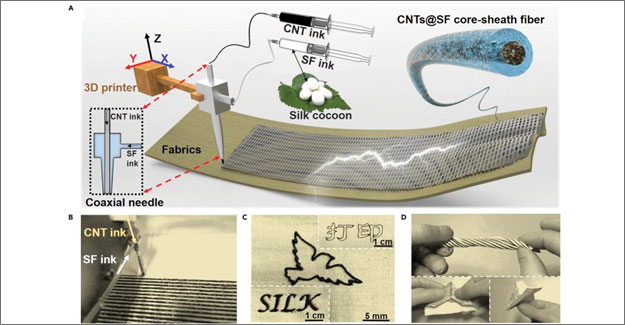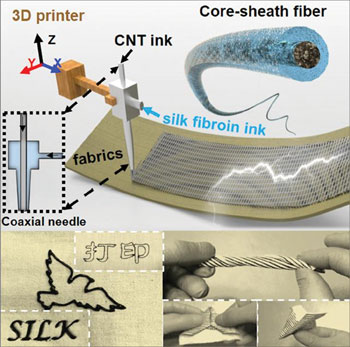
3D Printed Textile Fibres Can Turn Movement Into Energy
Chinese researchers have developed a new one-step 3D printing process to create electronic threads for e-textiles. These will harvest and store electricity on fabrics while making wearable technology less cumbersome.
Researchers from the Tsinghua University in China are working on making wearable tech more user-friendly and less cumbersome by developing fabrics with electronic threads.The new process developed by professor Yingying Zhang and her research team involves a one-step 3D printing process which is used to print flexible electronic fibres onto textiles.
She explains: "Generally, the attachment of rigid and bulky electronic on textile will deteriorate the breathability and flexibility of textiles, leading to a poor wearing comfort. One way to alleviate this problem is to develop flexible functional fibres in a textile."
The team uses a 3D printer with a coaxial needle. The needle draws patterns onto fabric using core-sheath fibres and the textile can then turn movement into energy. Zhang believes that their work shows the textiles "could be used for energy-management purpose, such as for harvesting and storing energy."
Developing a one-step process
 What's special about Zhang's team's technique is that it is a one-step process. Other groups of researchers are working on integrating electronic components into fibres but relying on multi-step processes which take more time and effort.
To 3D print the e-textiles, the researchers used two inks which were a carbon nanotube solution and silkworm silk. The first builds the conductive core of fibres and the latter is used as an insulating sheath, Zhang explains.
The researchers then filled injection syringes with the inks and attached these to the coaxial nozzle on the 3D printer. They then drew customer-designed patterns, such as Chinese characters and a picture of a pigeon, with the printer.
"For harvesting energy, the silk fibroin sheath is used to induce electrons and the carbon nanotube core is used to transport the electrons… The mechanism is based on the coupling effect of contact electrification and electrostatic induction. The silk fibroin sheath tends to lose electrons when contacting with other materials - with a low-level position in the triboelectric series. Therefore, the contact/separation of the two parts will generate a variable dipole moment, leading to the flow of electrons, thus generating electricity, in the electrodes," explains Zhang.
Next, they plan to develop a new technique for large-scale fabrication and integration of flexible electronics and e-textiles.
What's special about Zhang's team's technique is that it is a one-step process. Other groups of researchers are working on integrating electronic components into fibres but relying on multi-step processes which take more time and effort.
To 3D print the e-textiles, the researchers used two inks which were a carbon nanotube solution and silkworm silk. The first builds the conductive core of fibres and the latter is used as an insulating sheath, Zhang explains.
The researchers then filled injection syringes with the inks and attached these to the coaxial nozzle on the 3D printer. They then drew customer-designed patterns, such as Chinese characters and a picture of a pigeon, with the printer.
"For harvesting energy, the silk fibroin sheath is used to induce electrons and the carbon nanotube core is used to transport the electrons… The mechanism is based on the coupling effect of contact electrification and electrostatic induction. The silk fibroin sheath tends to lose electrons when contacting with other materials - with a low-level position in the triboelectric series. Therefore, the contact/separation of the two parts will generate a variable dipole moment, leading to the flow of electrons, thus generating electricity, in the electrodes," explains Zhang.
Next, they plan to develop a new technique for large-scale fabrication and integration of flexible electronics and e-textiles.

Textile Excellence
If you wish to Subscribe to Textile Excellence Print Edition, kindly fill in the below form and we shall get back to you with details.








